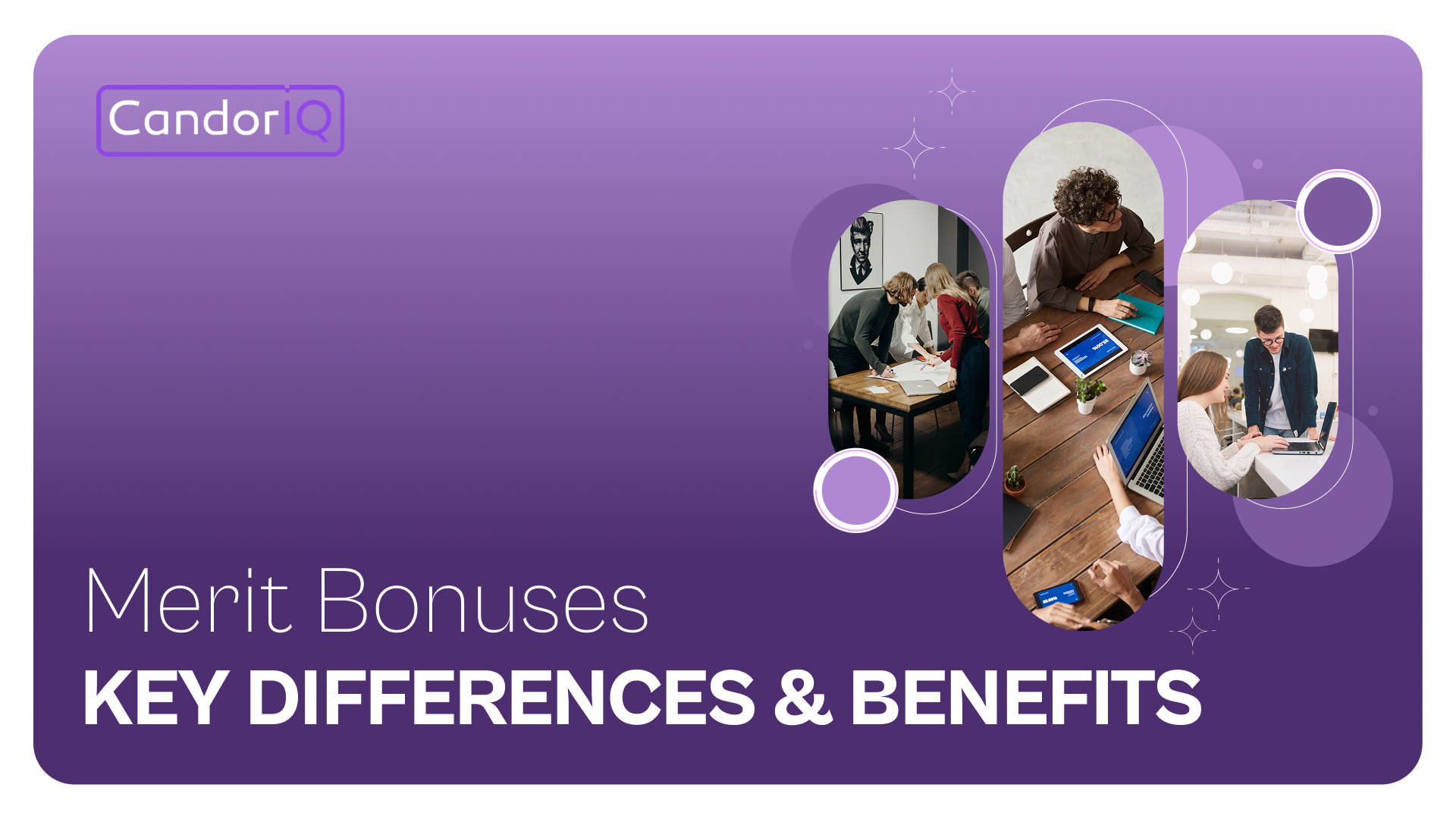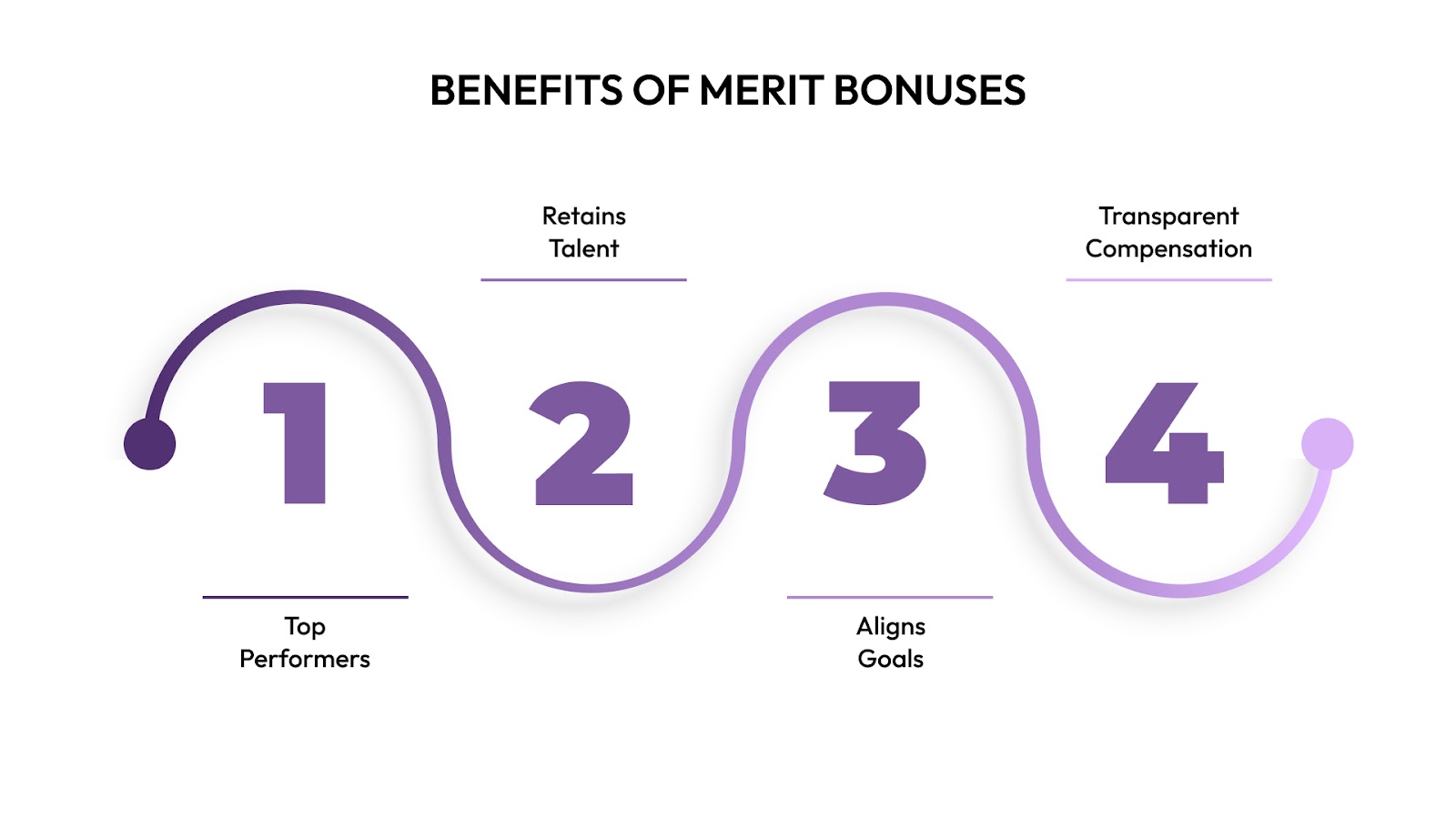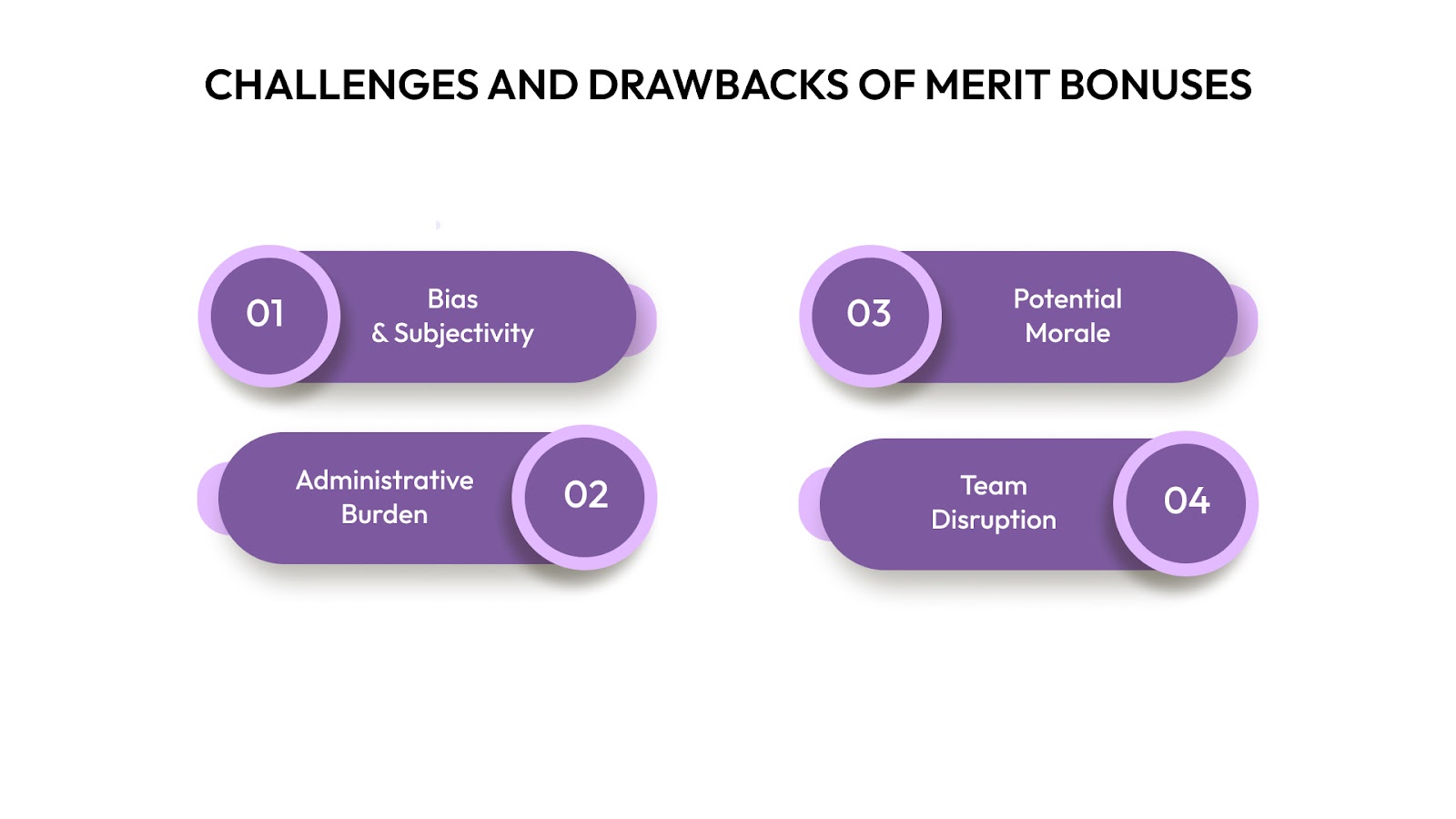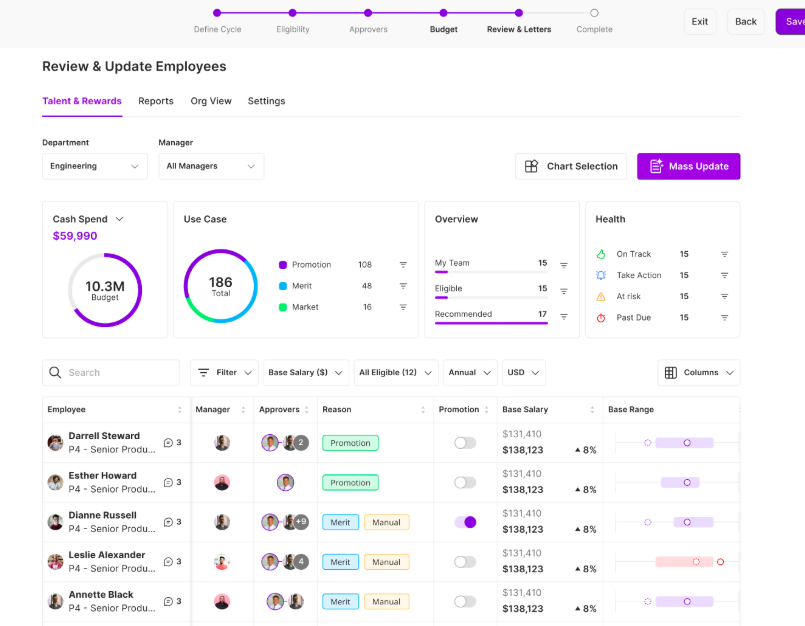Understanding Merit Bonuses: Key Differences and Benefits
Explore how merit bonus motivates employees, align with business goals, and best practices for ensuring fairness, consistency, and performance-based rewards.

Employees want to feel their hard work is appreciated, and a merit bonus is one of the most effective ways to show that their contributions matter. These rewards are a clear signal that effort and results are recognized, helping foster a culture of excellence.
A merit bonus can go beyond just offering financial incentives; it reinforces the connection between individual performance and the company’s goals.
Today, we'll see how merit bonuses work, how they differ from other compensation models, and how to implement them successfully in your organization.
TL;DR
- What is a Merit Bonus? A merit bonus is a performance-based reward given to employees for outstanding past performance, typically awarded during performance reviews.
- Merit Bonus vs. Other Bonus Types: Merit bonuses recognize past achievements, while performance bonuses are tied to future goals, and merit pay is a permanent salary increase.
- Benefits of Merit Bonus: Merit bonuses motivate employees, align performance with company goals, and help retain top talent.
- Challenges of Merit Bonus: Bias in evaluations, administrative burden, and potential employee dissatisfaction for non-recipients.
- Best Practices for Implementing Merit Bonuses: Establish clear merit-based performance evaluation criteria, ensure transparency, and use HR technology for efficient implementation.
What is a Merit Bonus?
A merit bonus is a one-time reward given to employees based on their past performance. Unlike regular pay raises, it recognizes specific achievements and contributions over a set period, usually following annual performance reviews.
This type of bonus is often used to reward high performers without adjusting their regular salary. By offering a merit bonus, companies can recognize exceptional work on a temporary basis, giving employees recognition for their efforts while maintaining stable salary structures.
Now, let’s understand how it compares to other types of performance-based rewards.
Merit Bonus vs. Other Bonus Types
To fully grasp the role of a merit bonus, it’s important to understand how they compare to other bonus types. While they all serve as rewards, each one is tied to different performance metrics and objectives.
The table below highlights the key differences between merit bonus, performance bonus, incentive bonus, and merit pay.
Having clarified how merit bonus compares, let’s now look at the distinct advantages they bring to organizations.
Benefits of Merit Bonuses

Merit bonus offers key advantages for organizations looking to motivate employees, drive performance, and align compensation with business goals. Below are the primary benefits:
- Motivates Top Performers: Recognizing exceptional work with merit bonuses boosts employee morale, encouraging continued excellence and higher productivity.
- Attracts and Retains Talent: Offering merit bonuses shows a commitment to rewarding hard work, making it easier to retain high performers and attract top talent.
- Aligns Employee Goals with Business Objectives: By linking rewards to performance, merit bonuses ensure that employees’ efforts align with the organization’s broader goals, driving both personal and business growth.
- Ensures Fair and Transparent Compensation: Merit bonuses contribute to a culture of fairness by making performance evaluations and reward distribution clear, building transparency in compensation practices.
While merit bonus offers clear advantages, it's also important to consider the potential challenges that can arise during their implementation.
Challenges and Drawbacks of Merit Bonuses

Merit bonus presents some challenges that organizations must address to ensure effectiveness and fairness. Here are the key drawbacks:
1. Bias and Subjectivity
Merit bonuses can be influenced by manager bias or personal preferences if there are no clear, standardized evaluation criteria. This can lead to unfair or inconsistent distribution, where some employees may be favored over others.
2. Administrative Burden
Managing merit bonuses can be time-consuming for HR teams, especially when performance criteria are subjective. The process of evaluating employee performance and distributing bonuses can strain resources.
3. Potential Morale Issues
Employees who do not receive a merit bonus may feel demotivated or overlooked, particularly if the evaluation process lacks transparency. Clear communication about how decisions are made can help mitigate these feelings and ensure employees feel valued, even if they are not rewarded.
4. Risk of Undermining Teamwork
Merit bonuses based solely on individual performance can foster unhealthy competition and discourage collaboration. Employees may focus more on personal achievements than team success.
With these challenges in mind, let’s now understand how to calculate a merit bonus accurately.
How to Calculate a Merit Bonus
Calculating a merit bonus requires more than just applying a simple formula. It involves adjusting for role, performance, and overall impact. Below are the essential components of the process:
Standard Calculation
The standard formula for a merit bonus involves multiplying the employee's salary by the percentage of the merit increase.
- Formula:
Current Salary x Merit Increase Percentage = Merit Bonus - Example: For an employee earning $80,000 annually with a 3% merit bonus, the calculation would be:
$80,000 x 0.03 = $2,400.
Tailoring to Role and Performance
Employees in high-impact roles or those consistently exceeding expectations may receive larger merit bonuses.
- Role-Based Adjustments: Higher-level roles or those with significant responsibilities often warrant larger bonuses.
- Performance-Based Adjustments: Employees whose performance consistently surpasses expectations or contributes significantly to the organization may be rewarded with higher bonus percentages.
Using a Merit Matrix
Companies often use a merit matrix to define the relationship between performance levels and merit bonuses.
- Performance Levels: Employees are rated according to how they perform against set goals.
- Bonus Percentage: Each performance category (e.g., exceptional, meets expectations, needs improvement) corresponds to a specific merit bonus percentage.
Considering Budget and Equity
Budget constraints and fairness are essential considerations when determining merit bonuses.
- Budget Limits: Set a budget for merit bonuses based on the company’s overall performance or departmental results.
- Equity: Ensure merit bonuses are fairly distributed to maintain transparency and avoid creating perceptions of favoritism.
With a clear understanding of how to calculate a merit bonus, it’s helpful to look at how they’re applied in real-world scenarios to fully appreciate their impact.
Examples of Merit Bonuses in Action
Here are some real-world examples of how merit bonuses can be applied to recognize and reward outstanding performance:
1. Annual Performance Reviews
Employees who exceed expectations during their annual performance reviews or reach significant milestones throughout the year are awarded a merit bonus.
Example: An employee who consistently meets and exceeds their sales targets could receive a merit bonus at the end of the fiscal year.
2. Project-Based Recognition
Merit bonus can also be awarded for successfully completing high-impact projects or leading company-wide initiatives.
Example: An employee leading a successful product launch might be recognized with a merit bonus for their exceptional leadership and effort.
3. Leadership and Initiative
Employees who take on additional responsibilities or drive meaningful organizational changes are often rewarded with a merit bonus.
Example: An employee who identifies and implements a cost-saving strategy may be awarded a merit bonus for their contribution to the company’s efficiency.
Seeing how merit bonuses work in practice emphasizes the need for a structured approach. Let’s look at the best practices for implementing merit bonuses.
Best Practices for Implementing Merit Bonuses
To ensure the effective implementation of merit bonuses, consider the following best practices:
1. Using HR Technology
Using the right HR technology can significantly simplify the process of evaluating and distributing merit bonuses, ensuring that the process is both efficient and fair.
With solutions like CandorIQ’s Compensation Cycle, organizations can automate many manual processes, enabling faster and more accurate decision-making.

- CandorIQ’s Compensation Cycle allows companies to automate merit bonus reviews with built-in approval logic, making the process more efficient and less prone to errors.
- It also tracks budgets and raises in real-time, providing both HR and finance leaders with visibility into compensation data. This helps ensure that merit bonuses align with company goals and budget constraints.
- Real-time collaboration ensures that all stakeholders are aligned, making the merit bonus process more transparent and reducing the risk of miscommunication.
Book a demo today and let CandorIQ simplify your compensation process.
2. Clear and Standardized Evaluation Criteria
Having clear and consistent performance metrics ensures employees are assessed fairly.
- Set measurable performance criteria that directly align with each employee’s role and responsibilities.
- Standardize the evaluation process across departments to maintain consistency in how merit bonuses are awarded.
3. Transparent Communication
Open communication about how merit bonus is awarded helps set the right expectations and build trust.
- Clearly explain the criteria and timelines for earning merit bonuses to all employees.
- Regularly update employees on their performance relative to merit bonus goals, keeping them engaged in the process.
4. Regular Performance Reviews
Conducting ongoing performance reviews ensures alignment and helps track progress toward earning merit bonuses.
- Schedule regular check-ins to review progress and provide constructive feedback.
- Use these sessions to set new goals and adjust performance expectations, ensuring employees are always clear on how to earn their merit bonuses.
These best practices help ensure that merit bonuses are fair, efficient, and aligned with the company's goals.

Why Choose CandorIQ for Your Compensation Management?
CandorIQ is an all-in-one platform designed to simplify the complex process of managing compensation, headcount planning, and employee retention. It brings together all your compensation tools into one smooth system, eliminating the need for spreadsheets and disconnected processes.
CandorIQ's solutions automate merit and bonus reviews, ensure alignment with company goals, and reduce administrative burdens with built-in approval logic
FAQs
Q1. How can I ensure fairness in the distribution of merit bonuses?
A1. Set clear, objective performance criteria and apply them consistently across the organization. Use merit-based evaluations that focus on measurable outcomes, and hold calibration meetings among managers to align expectations and minimize bias.
Q2. What should I do if an employee doesn't receive a merit increase?
A2. Provide clear feedback during the review, outlining areas for improvement. Offer development plans to help the employee work toward earning a merit bonus in the future.
Q3. How can I align merit bonuses with company performance goals?
A3. Set individual goals that contribute to company success. Evaluate each employee's impact on these goals and adjust their bonuses accordingly, ensuring alignment with business objectives.
Q4. How often should merit bonuses be given?
A4. Merit bonuses are typically awarded annually or semi-annually, aligning with your company’s performance review cycle. Some companies may offer them quarterly, especially in fast-paced environments.
Q5. How do I handle discrepancies in merit bonus expectations across teams?
A5. Ensure standardized performance metrics across teams and align expectations. Regular communication between teams and HR helps maintain consistency and minimize misunderstandings about bonus distribution.


